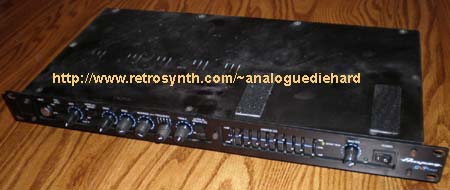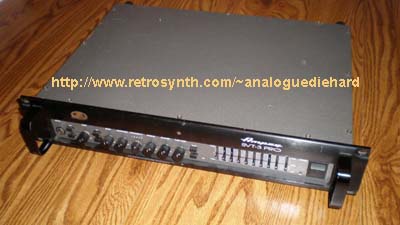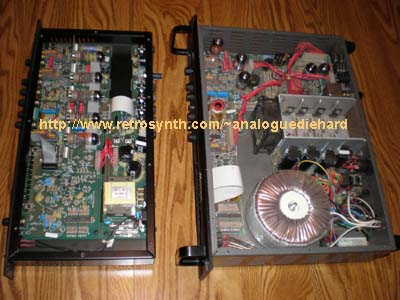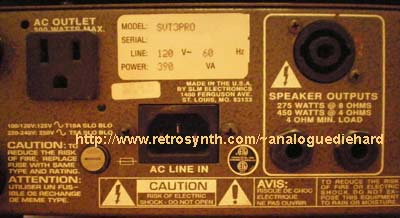Ampeg SVP-Pro Bass Preamp and SVT-3-Pro Bass Amplifier
Last Update 01-24-2010
My first taste in tube bass preamps was my
Tubeworks Blue Tube. While it was a good preamp, it is pretty
much a one trick pony and doesn't get much variety in tones. But
the Bluetube convinced me that a tube preamp went a long way to shaping
the tone of a bass guitar. So I
found this used SVP-Pro preamp in a store and really liked the tone
variety. When I got home, some internet searching revealed that
not only did it have a tube front end, but the tone controls were based
around tubes and it also had a tube that was dedicated to
overdrive. The Blue Tube is nice but the SVP-Pro is a bass
players' preamp. So the next day I brought my Alvarez six string
bass for the acid test (low B) and the SVP-Pro soon became another
fixture in my ever expanding studio.
The SVT3-Pro came later when I needed for a bass amp for gigging.
I have a modular system with the SVP and other components depending on
my gig situation,
IE it is the system I use if I am playing keyboards and bass. But
for gigs when I am only playing bass guitar, the modular system is
overkill. If I matched the tone controls and graphic EQ (hint the
settings in the pictures are NOT what I use) then both sound the
same. When the overdrive is used, the similarities end there.
Both overdrive circuits employ a 12AU7 low gain tube. The 12AU7
is better suited for overdrive than the 12AX7 because you don't need
all that distortion for bass guitar. The SVT3 overdrive tube is
placed in the power amp section. Since the SVP lacks a power amp,
the overdrive tube is placed before
the EQ section, right after the input preamp. The timbre is
different between the two when overdrive is active. The SVP
overdrive is more effective for dynamic touch - when I slap-n-pop the
12AU7 pushed into overdrive which adds harmonics that help the tone cut
through. The SVT3 overdrive gets a really nice punch on a stage
when I play fingerstyle.
Both units are descendents of the original SVT bass amp, a landmark
Ampeg design that was released in 1969. The SVT was the first
real bass amp designed for large venues and they were very popular with
bass players. A complete SVT system included the head and two
speaker cablinets each loaded with eight ten inch speakers. I
have heard (and felt) a complete system in full flight at a large bar I
used to frequent, and the sound radiated everywhere even all the way in
the back. It was also a heavy system to cart around and the SVT
bass head was a very heavy head, packing in two large transformers
(power and OT) and a sextet of 6550 output tubes. Ampeg designed
some failsafe features into the head that prevented a tube fault from
disabling the entire amp - if a tube went faulty in the middle of a gig
you could still play the amp, albiet at reduced output power. The
complete SVT system was practically indestructable.
The closest modern equivalent is the SVT2-Pro which included the output
tube sextet. The SVP-Pro preamp is lifted right out of the
SVT2-Pro. The SVT3-Pro uses a solid state amplifier - no output
tubes.
A comparision of both SVP-Pro and SVT3-Pro units:
The front panel controls are almost identical.
Both units use a 12AX7 tube for the input preamp and the EQs are based
around 12AX7 tubes - like the classic SVT bass head. The graphic
EQ is solid state and was not a feature in the SVT however it is a
practical addition. You can get
aggressive sounds by pushing the input preamp into distortion.
The EQ is really effective (better than the Bluetube) and the sweepable
mid really helps dial in your tone. While the original SVT had
three
selectable frequency ranges for the mid EQ, the SVP/SVT3 has five
(220hz, 450hz, 800hz, 1.6Khz, 3Khz). The EQs have +/-12dB
boost/cut ranges, while the graphic EQ has +8/-10dB boost/cut
ranges. A gain makeup is provided in the graphic EQ.
Pushbuttons engage various tone shaping options. "Ultra Lo"
emphasizes the low end spectrum with a +3dB boost at 40hz and and -12dB
cut at 500hz, quite effective. "Ultra High" gives you a +8dB
boost at 8Khz that is effective for playing with picks. "Bright"
provides a +7dB boost at 2Khz, I have yet to find an application for
this as it is a bit harsh. "Mute" silences all the outputs with
the exception of the tuner output for silent tuning onstage.
Very important:
many Ampeg owners complain of excess noise (Bloody
whiners. Just Kidding).
The Ampeg units left
the factory with cheap Chinese tubes installed, the worst made on the
planet (which were also the cheapest, and the beancounters are always
emphasizing cheapest components to keep the retail reasonable and their
bonus checks viable). My units were not immune from this.
You can drastically reduce the noise by replacing the inferior Chinese
tubes with better ones from Groove Tubes, Rubys, JJ, or
Electro-Harmonix. In fact the signal-to-noise ratio not only
improved on my units with the better tubes, but the output signal was
also hotter!
As you can see from the pic showing the inside of both units, the
circuit boards are definitely not the same. Whether they are the
same EQ and preamp circuits I cannot ascertain without a
schematic. Certainly the SVT3 preamp tubes are not going to fit
in a 1U rack standing upright, so no surprise that the boards are
different. But they do show good workmanship. Both these
units were made in the US, later units were made in Asia and are
reported to be inferior to the US-made Ampegs.
Both units sport identical outputs, with the exception of speaker
outputs on the preamp-only SVP-Pro. Tuner out is an unprocessed
direct output to your tuner, which is unaffected by the MUTE button for
silent tuning onstage. An effects loop gives you access to your
favorite processors, I have a JBL/UREI 7110 compressor patched into
mine. There is a transformer isolated balanced output for DI to
FOH or recording station, and it is switchable to pre or post EQ and
the level is variable (the SVT3-Pro has an additional unballanced DI
output and ground can be lifted by pulling the Level
potentiometer). Preamp Out gives you the final processed signal,
the SVT3 adds a power amp input jack.

Home












